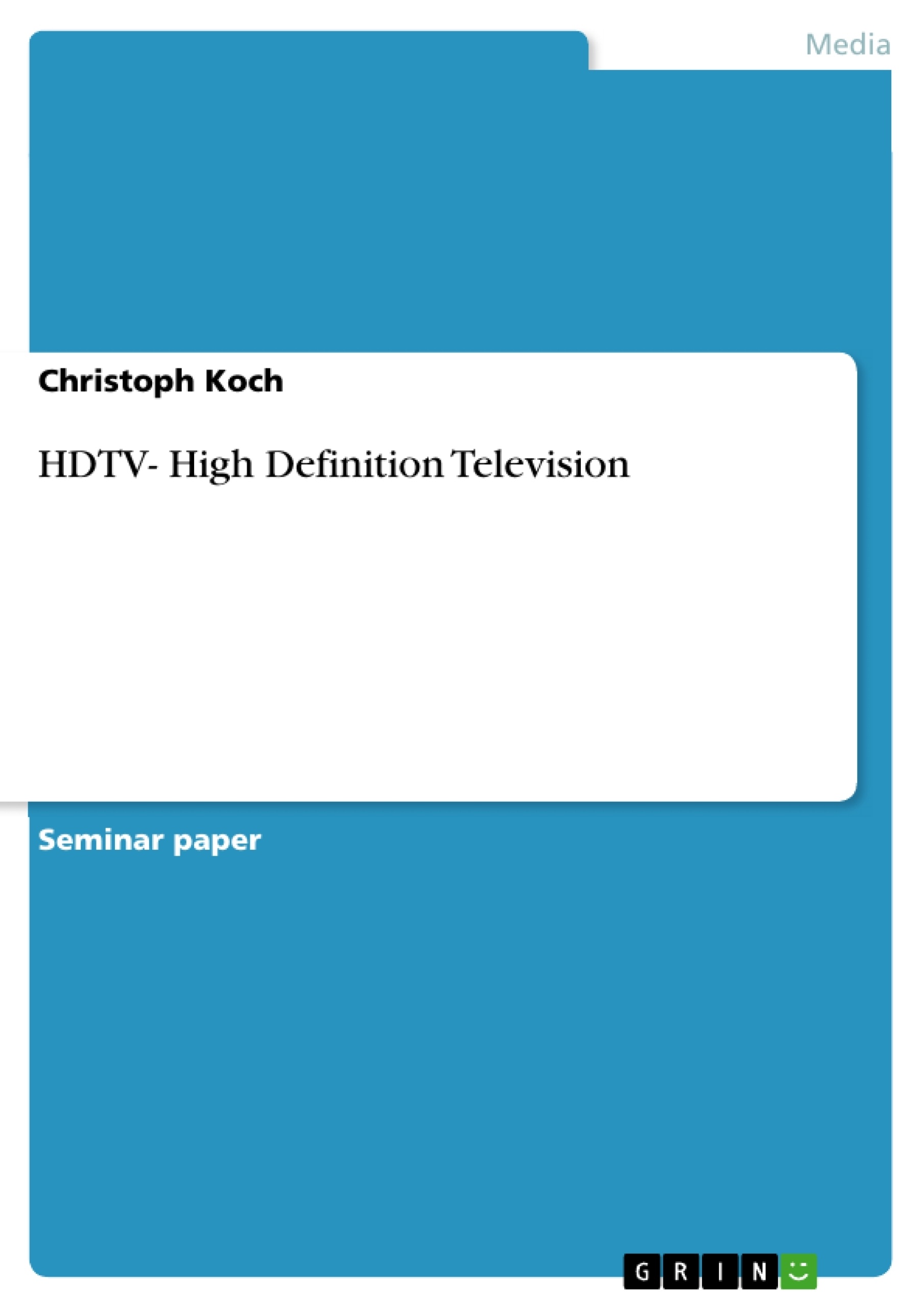Usually one would think that an emerging new technology either fails or succeeds, since the consumers know what they want or need, and since the industry knows what is possible and what is not. But sometimes technologies keep coming back. Critics claim them dead but a few years later, they are more alive than ever. High Definition Television (HDTV) is one of those technologies.
This briefing paper aims to inform executives of the benefits and drawbacks of HDTV. It explains how this technology basically works, what problems it is designed to solve, who the major players are and what kinds of social, economic and regulatory issues have to be considered.
Inhaltsverzeichnis (Table of Contents)
- Introduction
- How HDTV works
- HDTVs background and who is promoting it
- Historical Development
- Players
Zielsetzung und Themenschwerpunkte (Objectives and Key Themes)
This briefing paper aims to inform executives of Nice and Easy Television (NET) about the advantages and disadvantages of HDTV. It explains the technology, the problems it addresses, key players, and relevant social, economic, and regulatory considerations.
- The technical aspects of HDTV and its differences from SDTV.
- The historical development and standardization of HDTV.
- The various stakeholders involved in HDTV's adoption and their competing interests.
- The economic and regulatory challenges facing HDTV's widespread implementation.
- The potential benefits and drawbacks of HDTV for broadcasters and consumers.
Zusammenfassung der Kapitel (Chapter Summaries)
Introduction: This introductory section establishes HDTV as a technology that has experienced periods of both perceived failure and resurgence. It highlights the paper's objective: to inform Nice and Easy Television (NET) executives about the technology's benefits and drawbacks, its functionality, the key players involved, and relevant social, economic, and regulatory issues.
How HDTV works: This chapter details the technical differences between HDTV and SDTV, focusing on resolution and scanning methods. It explains that HDTV uses higher resolution (1080 x 1920 or 720 x 1280 pixels) compared to SDTV (480 x 704 or 640 pixels), resulting in superior picture quality. The chapter differentiates between interlaced and progressive scanning, explaining the trade-off between bandwidth and picture quality. It also highlights the difference in aspect ratio between HDTV (16:9) and standard TV (4:3), along with the improved sound quality offered by HDTV's six channels of surround sound. The chapter emphasizes that compatibility between various HDTV resolution formats has been ensured.
HDTVs background and who is promoting it: This section delves into the history of HDTV, tracing its development from early Japanese research to the formation of the Grand Alliance and the establishment of a standardized digital transmission system. It discusses the key players involved in HDTV's development and adoption, including consumer electronics manufacturers, the cable industry, and the Federal Communications Commission (FCC). The chapter highlights the differing motivations of these players—manufacturers aiming for increased sales, the cable industry grappling with bandwidth constraints and channel capacity, and the FCC considering regulations such as a "must carry" rule—all impacting the pace and manner of HDTV's adoption. The potential economic benefits of the transition, estimated to be at least $125 billion, are mentioned.
Schlüsselwörter (Keywords)
High Definition Television (HDTV), Standard Definition Television (SDTV), digital television (DTV), resolution, interlaced scanning, progressive scanning, aspect ratio, surround sound, Grand Alliance, Federal Communications Commission (FCC), cable industry, consumer electronics manufacturers, economic impact, regulatory issues, bandwidth.
High Definition Television (HDTV) Briefing Paper: Frequently Asked Questions
What is the purpose of this briefing paper?
This briefing paper aims to inform executives of Nice and Easy Television (NET) about the advantages and disadvantages of HDTV. It explains the technology, the problems it addresses, key players, and relevant social, economic, and regulatory considerations.
What are the key themes explored in the paper?
The paper explores the technical aspects of HDTV and its differences from SDTV, the historical development and standardization of HDTV, the various stakeholders involved and their competing interests, the economic and regulatory challenges, and the potential benefits and drawbacks for broadcasters and consumers.
How does HDTV work, and what are its technical differences from SDTV?
HDTV uses higher resolution (1080 x 1920 or 720 x 1280 pixels) than SDTV (480 x 704 or 640 pixels), resulting in superior picture quality. It differentiates between interlaced and progressive scanning, impacting bandwidth and picture quality. HDTV also features a 16:9 aspect ratio compared to SDTV's 4:3 and offers six channels of surround sound.
What is the history of HDTV, and who are the key players involved in its development and adoption?
The paper traces HDTV's development from early Japanese research to the formation of the Grand Alliance and standardization. Key players include consumer electronics manufacturers, the cable industry, and the Federal Communications Commission (FCC). Their motivations—increased sales, bandwidth management, and regulation—influenced HDTV's adoption.
What are the economic and regulatory challenges facing HDTV's widespread implementation?
The paper discusses the economic benefits (estimated at least $125 billion) and the regulatory issues such as bandwidth constraints for the cable industry and FCC regulations, including potential "must carry" rules, that impacted the pace and manner of HDTV's adoption.
What are the potential benefits and drawbacks of HDTV for broadcasters and consumers?
The benefits include significantly improved picture and sound quality due to higher resolution, different scanning methods, and surround sound. Drawbacks might include the initial cost of equipment and potential bandwidth limitations. The paper doesn't explicitly detail consumer drawbacks beyond the initial cost implication.
What are the main keywords associated with this briefing paper?
High Definition Television (HDTV), Standard Definition Television (SDTV), digital television (DTV), resolution, interlaced scanning, progressive scanning, aspect ratio, surround sound, Grand Alliance, Federal Communications Commission (FCC), cable industry, consumer electronics manufacturers, economic impact, regulatory issues, bandwidth.
- Citation du texte
- Christoph Koch (Auteur), 1998, HDTV- High Definition Television, Munich, GRIN Verlag, https://www.grin.com/document/3947



